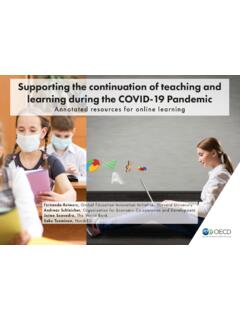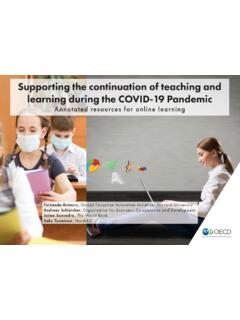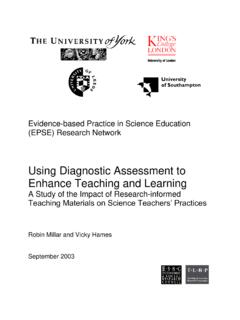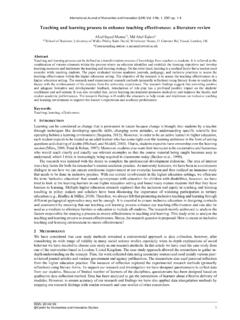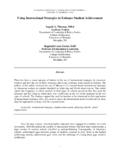Transcription of Using Simulations to Enhance Teaching and Learning
1 Volume 21 No. 2 JOURNAL The VSTE Journal is published by the Virginia Society for Technology in Education. Permission is granted to copy and distribute single articles from this publication for non-profit use with copyright notice. Contents copyright 2006, VSTE All rights reserved. Vol. 21, No. 2 1 Using Simulations to Enhance Teaching and Learning : Encouraging the Creative Process Teresa Coffman, echnology integration has become popular in education and as teachers we are always look-ing for ways to effectively utilize technology tools in our classrooms. At its inception, technol-ogy in education meant bringing in computers for teachers to use and any available software that was available.
2 How times have changed! As technology integration evolves in the classroom, we now have a wide variety of Teaching tools available to help facilitate student Learning . One such tool is Simulations . A computer simulation is a Teaching tool used to provide students with a realistic experience. It can serve as a technique for enhancing Learning and increase a student s interest and awareness in the topic being discussed. Simulations provide opportunities for learners to explore environments that mirror real-world situations or complex ideas. Simulations also provide innovative ways to use technology. New computer technologies allow for a variety of strategies to design Learning environ-ments that are realistic, authentic, engaging, and fun (Kirkley & Kirkley, 2005).
3 During the fall 2005 semester, I worked with graduate level students in a Leadership in Edu-cational Technology course on Simulations . As most are K-12 teachers, the focus was on creating a technology-related simulation that could be used in their classrooms. The software program used for this activity was Microworlds EX ( ). This program is designed for middle school students and is built on the LOGO programming language. This article defines and describes what Simulations are as well as the process my students (prospective teachers working toward certification and/or practicing teachers working on their Mas-T The VSTE Journal is published by the Virginia Society for Technology in Education.)
4 Permission is granted to copy and distribute single articles from this publication for non-profit use with copyright notice. Contents copyright 2006, VSTE All rights reserved. Vol. 21, No. 2 2 Using Simulations for Teaching & Learning ter s degree) went through as they designed and developed their very first technology-related simu-lation Using the LOGO programming language. Based on the results, some strategies for future teacher training and development are given. How Simulations Work Simulations provide students with an opportunity to practice problem based Learning through a specific task, issue, crisis, or problem. An experience or real-life situation is imitated. When the situation or problem is presented, students work together to think of a possible solution and prove that it works or fits in with certain decision criteria.
5 It is important to note that there is no one right answer or quick solution (Gredler, 1992). Students are generally assigned roles and are expected to act within that role or setting re-garding the subject matter and issues presented. Students carry out their roles in the simulation ac-cording to predetermined behavioral characteristics and descriptions regarding their topic. They be-come the character in the simulation and experience the reality of acting in the situation. It is impossible to know with certainty the outcome of a simulation. It depends on how the learners experience their role and the extent to which they develop it. As such, students take owner-ship of their roles, have the responsibility for carrying out their assigned activities, and ultimately take responsibility for their own Learning .
6 During a simulation, the instructor functions more as a fa-cilitator, helper, and resource person and less as an expert, judge, or tester (Hertel & Millis, 2002). This truly enhances the constructivist Learning approach as students garner meaning from their inter-action with the environment. Cognitive conflict or puzzlement then becomes the stimulus for learn-Figure 1. MicroWorlds Simulation Ecology of a Pond The VSTE Journal is published by the Virginia Society for Technology in Education. Permission is granted to copy and distribute single articles from this publication for non-profit use with copyright notice. Contents copyright 2006, VSTE All rights reserved. Vol. 21, No.
7 2 3 Using Simulations for Teaching & Learning ing and knowledge evolves through social negotiation and individual understanding (Kirkley & Kirk-ley, 2005). How Simulations Enhance Learning Simulations provide students with a very real experience and as such, they require a stu-dent s absolute involvement and participation. Students are interested and more aware of the topic and function as active participants (Hertel & Millis, 2002). This ultimately allows them to develop leadership skills and become more adept at analysis and problem solving activities. A constructivist Learning environment is created whereby students weave together interdependent elements and in-formation to solve real-world problems.
8 The simulation thereby promotes a transfer of knowledge and helps with not only the education but also the application of a particular issue or concept. Ulti-mately students learn how to think critically in a complex situation (Brumfield, 2005). Developing a Simulation A simulation should be developed and planned based on the objectives of the Learning activ-ity. Once the objectives are known and established, the scope of the simulation can be defined. What question is going to be answered, what do the members plan to accomplish? Prepare students for the simulation by identifying critical concepts, skills, or content that is important for them to know before and during the simulation.
9 The role of each of the participants must then be identified and as-signed. Students need to have a good understanding of who they are during the simulation, what they will be doing, and what is expected of them. An overview of the situation should be provided as well as an introduction to the simulation. Once the exercise is completed, a debriefing is also neces-sary to fully assess and go through what happened during the simulation and ascertain student com-ments and reactions to the experience. Simulation issues, processes, and outcomes can then be linked to course concepts and Learning objectives. General Learning objectives commonly achieved through Simulations include: Improved student awareness of a topic or subject Real-world and practical application of course concepts Enhanced analytical ability to resolve issues and problems in the subject matter Increased exposure to complex real-life experiences Criteria should be established for grading attendance and participation as well as deliverables such as reports.
10 Rules also need to be established for how students will interact with each other, how they will interact with the teacher, and whether outside resources or research is allowed during the simulation (Hertel & Millis, 2002). Simulations Utilizing Technology Simulations are one way to incorporate an innovative use of technology into the Learning envi-ronment. Technology is not needed for the creation or administration of a simulation but technology can Enhance the overall presence and impact of the simulation for students. The VSTE Journal is published by the Virginia Society for Technology in Education. Permission is granted to copy and distribute single articles from this publication for non-profit use with copyright notice.
